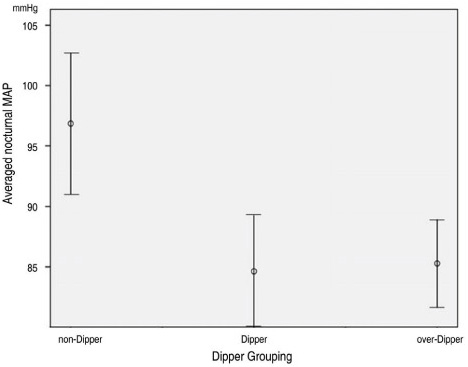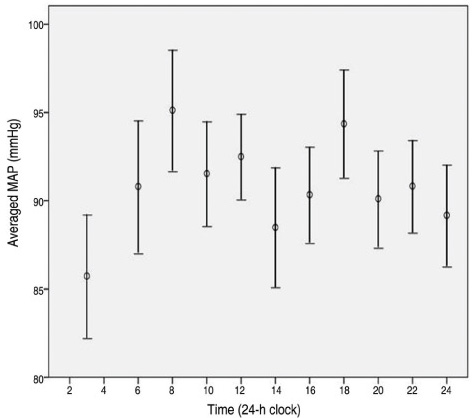Korean J Ophthalmol.
2009 Mar;23(1):32-39. 10.3341/kjo.2009.23.1.32.
Twenty-Four Hour Blood Pressure Pattern in Patients With Normal Tension Glaucoma in the Habitual Position
- Affiliations
-
- 1Department of Ophthalmology, University of Ulsan, College of Medicine, Asan Medical Center, Seoul, Korea. mskook@amc.seoul.kr
- 2HanGil Eye Hospital, Incheon, Korea.
- KMID: 1115649
- DOI: http://doi.org/10.3341/kjo.2009.23.1.32
Abstract
- PURPOSE
To investigate the relationship between blood pressure (BP) parameters in the habitual position and glaucomatous damage at initial presentation in patients with untreated normal tension glaucoma (NTG).
METHODS
Fifty-four eyes from 54 subjects diagnosed with NTG were consecutively enrolled. BP was measured with an automated ambulatory monitoring device in the habitual position during 24-hour in-hospitalization. Patients were classified into three groups: non-dippers, dippers, and over-dippers. corresponded to the degree of reduction in their nocturnal mean arterial pressure (MAP) compared with their diurnal MAP. Regression models were used to evaluate potential risk factors, including: age, pre-admission office intraocular pressure (IOP), central corneal thickness (CCT), and BP parameters. Functional outcome variables for glaucomatous damage included mean deviation (MD) and pattern standard deviation (PSD) on a Humphrey field analyzer (HFA). Anatomic outcome variables were TSNIT score (temporal, superior, nasal, inferior, and temporal) average, superior average, inferior average, and nerve fiber indicator (NFI) score on scanning laser polarimetry with variable corneal compensation (SLP-VCC; GDx-VCC).
RESULTS
Marked systolic blood pressure (SBP), diastolic blood pressure (DBP), and MAP fluctuation were noted in the over-dipper group (p<0.05). A linear regression analysis model revealed that nocturnal trough DBP and MAP, average nocturnal SBP, and MAP were all significantly associated with a decreased average TSNIT score and an increased NFI score.
CONCLUSIONS
Nocturnal BP reduction estimated in the habitual position was associated with structural damage in eyes with NTG. This finding may suggest systemic vascular etiology of NTG development associated with nocturnal BP reduction.
MeSH Terms
-
Adult
Aged
Aged, 80 and over
Blood Pressure/*physiology
Blood Pressure Monitoring, Ambulatory/*methods
Circadian Rhythm/*physiology
Disease Progression
Female
Follow-Up Studies
Glaucoma, Open-Angle/diagnosis/*physiopathology
Humans
Intraocular Pressure/physiology
Male
Middle Aged
Nerve Fibers/pathology
Posture/*physiology
Prognosis
Prospective Studies
Retina/pathology
Risk Factors
Visual Fields
Figure
Cited by 2 articles
-
Association between Normal-tension Glaucoma and Allergic Rhinitis in a Korean Population-based Study
Areum Jeong, Soon Cheol Cha
J Korean Ophthalmol Soc. 2018;59(10):960-967. doi: 10.3341/jkos.2018.59.10.960.Correlation Between Nocturnal Dip and Progression of Glaucoma
Hong Ryung Seo, Won Yeol Ryu, Sae Heun Rho
J Korean Ophthalmol Soc. 2010;51(11):1471-1478. doi: 10.3341/jkos.2010.51.11.1471.
Reference
-
1. Hayeh SS. The optic nerve circulation in health and disease. Exp Eye Res. 1995. 61:259–272.2. Flammer J, Orgul S. Optic nerve blood-flow abnormalities in glaucoma. Prog Retin Eye Res. 1998. 17:267–289.3. Bresson-Dumont H, Bechetoille A. [Role of arterial blood pressure in the development of glaucomatous lesions]. J Fr Ophtalmol. 1996. 19:435–442.4. Cioffi GA, Sullivan P. The effect of chronic ischemia on the primate optic nerve. Eur J Ophthalmol. 1999. 9:suppl 1. S34–S36.5. Costa VP, Harris A, Stefansson E, et al. The effects of antiglaucoma and systemic medications on ocular blood flow. Prog Retin Eye Res. 2003. 22:769–805.6. Hafez AS, Bizzarro R, Descovich D, Lesk MR. Correlation between finger blood flow and changes in optic nerve head blood flow following therapeutic intraocular pressure reduction. J Glaucoma. 2005. 14:448–454.7. Phelps CD, Corbett JJ. Migraine and low-tension glaucoma. A case-control study. Invest Ophthalmol vis Sci. 1985. 26:1105–1108.8. Morgan RW, Drance SM. Chronic open-angle glaucoma and ocular hypertension. An epidemiological study. Br J Ophthalmol. 1975. 59:211–215.9. Broadway DC, Drance SM. Glaucoma and vasospasm. Br J Ophthalmol. 1998. 82:862–870.10. Shimada K, Kawamoto A, Matsubayashi K, et al. Diurnal blood pressure variations and silent cerebrovascular damage in elderly patients with hypertension. J Hypertens. 1992. 10:875–878.11. Meyer JH, Brandi-Dohrn J, Funk J. Twenty four hour blood pressure monitoring in normal tension glaucoma. Br J Ophthalmol. 1996. 80:864–867.12. Bonomi L, Marchini G, Marraffa M, et al. Vascular risk factors for primary open angle glaucoma: the Egna-Neumarkt Study. Ophthalmology. 2000. 107:1287–1293.13. Collignon N, Dewe W, Guillaume S, Collignon-Brach J. Ambulatory blood pressure monitoring in glaucoma patients. The nocturnal systolic dip and its relationship with disease progression. Int Ophthalmol. 1998. 22:19–25.14. Graham SL, Drance SM. Nocturnal hypotension: role in glaucoma progression. Surv Ophthalmol. 1999. 43:Suppl 1. S10–S16.15. Liu JH. Diurnal measurement of intraocular pressure. J Glaucoma. 2001. 10:S39–S41.16. Tsukahara S, Sasaki T. Postural change of IOP in normal persons and in patients with primary wide open-angle glaucoma and low-tension glaucoma. Br J Ophthalmol. 1984. 68:389–392.17. Choi J, Jeong J, Cho HS, Kook MS. Effect of nocturnal blood pressure reduction on circadian fluctuation of mean ocular perfusion pressure: a risk factor for normal tension glaucoma. Invest Ophthalmol Vis Sci. 2006. 47:831–836.18. Choi J, Kim KH, Jeong J, et al. Circadian Fluctuation of Mean zOcular Perfusion Pressure Is a Consistent Risk Factor for Normal-Tension Glaucoma. Invest Ophthalmol Vis Sci. 2007. 48:104–111.19. Kook MS, Cho HS, Seong M, Choi J. Scanning laser polarimetry using variable corneal compensation in the detection of glaucoma with localized visual field defects. Ophthalmology. 2005. 112:1970–1978.20. Zhou Q, Weinreb RN. Individualized compensation of anterior segment birefringence during scanning laser polarimetry. Invest Ophthalmol Vis Sci. 2002. 43:2221–2228.21. Weinreb RN, Bowd C, Zangwill LM. Glaucoma detection using scanninglaser polarimetry with variable corneal polarization compensation. Arch Ophthalmol. 2003. 121:218–224.22. Verdecchia P, Schillaci G, Porcellati S. Dippers versus non dippers. J Hypertens. 1991. 9:S42–S44.23. Hayreh SS, Podhajsky P, Zimmerman MB. Role of nocturnal arterial hypotension in optic nerve head ischemic disorders. Ophthalmologica. 1999. 213:76–96.24. Jampol LM, Board RJ, Maumenee AE. Systemic hypotension and glaucomatous changes. Am J Ophthalmol. 1978. 85:154–159.25. Meyer JH, Brandi-Dohrn J, Funk J. Twenty four hour blood pressure monitoring in normal tension glaucoma. Br J Ophthalmol. 1996. 80:864–867.26. Pannarale G, Pannarale L, Arrico L, et al. Ambulatory blood pressure in patients with glaucoma. Invest Ophthalmol Vis Sci. 1996. 37:S30.27. Graham SL, Drance SM. Nocturnal hypotension: role in glaucoma progression. Surv Ophthalmol. 1999. 43:Suppl 1. S10–S16.28. Gramer E, Tausch M. The risk profile of the glaucomatous patient. Curr Opin Ophthalmol. 1995. 6:78–88.29. Berglund G. Goals of antihypertensive therapy, is there a point beyond which pressure reduction is dangerous? Am J Hypertens. 1989. 2:586–593.30. Criuckshank JM, thorp JM, Zacharias FJ. Benefits and potential harm of lowering high blood pressure. Lancet. 1987. 1(8533):581–583.31. Farnett L, Mulrow CD, Linn WD, et al. The J-curve phenomenon and the treatment of hypertension, is there a point beyond which pressre reduction is dangerous? JAMA. 1991. 265:489–495.32. Rouhiainen HJ, Terasvorta ME. Hemodynamic variables in progressive and non-progressive low tension glaucoma. Acta Ophthalmol. 1990. 68:34–36.33. Riccadonna M, Covi G, Pancera P, et al. Autonomic system activity and 24-hour blood pressure variations in subjects with normal- and high-tension glaucoma. J Glaucoma. 2003. 12:156–163.34. Yazici B, Usta E, Erturk H, Dilek K. Comparison of ambulatory blood pressure values in patients with glaucoma and ocular hypertension. Eye. 2003. 17:593–598.35. Feke GT, Pasquale LR. Retinal Blood Flow Response to Posture Change in Glaucoma Patients Compared with Healthy Subjects. Ophthalmology. 2008. 115:246–252.36. Evans DW, Harris A, Garrett M, et al. Glaucoma patients demonstrate faulty autoregulation of ocular blood flow during posture change. Br J Ophthalmol. 1999. 83:809–813.37. Leske MC, Heijl A, Hyman L, et al. Predictors of Long-term Progression in the early Manifest glaucoma Trial. Ophthalmology. 2007. 114:1965–1972.38. Fuchsjager-Mayrl G, Wally B, Georgopoulos M, et al. Ocular blood flow and systemic blood pressure in patients with primary open-angle glaucoma and ocular hypertension. Invest Ophthalmol Vis Sci. 2004. 45:834–839.39. Grunwald JE, Piltz JR, Hariprasad SM, Dupont J, Maguire aMG. Optic nerver blood flow in glaucoma: effect of systemic hypertension. Am J Ophthalmol. 1999. 127:516–522.40. Sugiyama T, Utsunomiya K, Ota H, et al. Comparative study of cerebral blood flow in patients with normal-tension glaucoma and control subjects. Am J Ophthalmol. 2006. 141:394–396.41. Shimada K, Kawamoto A, Matsubayashi K, et al. Diurnal blood pressure variations and silent cerebrovascular damage in elderly patients with hypertension. J Hypertens. 1992. 10:875–878.42. Shimada K, Kario K. Altered circadian rhythm of blood pressure and cerebrovascular damage. Blood Press Monit. 1997. 2:333–338.43. Manabe Y, Murakami T, Iwatsuki K, et al. Nocturnal blood pressure dip in CADASIL. J Neurol Sci. 2001. 193:13–16.44. Rufa A, Dotti MT, Franchi M, et al. Systemic blood pressure profile in cerebral autosomal dominant arteriopathy with subcortical infarcts and leukoencephalopathy. Stroke. 2005. 36:2554–2558.45. Aliev G, Obrenovich ME, Seyidova D, de la Torre JC. Exploring ischemia-induced vascular lesions and potential pharmacological intervention strategies. Histol Histopathol. 2005. 20:261–273.46. Reimer KA, Tanaka M, Murry CE, et al. Evaluation of free radical injury in myocardium. Toxicol Pathol. 1990. 18:470–480.47. Sayegh FN, Weigelin E. Functional ophthalmodynamometry: comparison between brachial and ophthalmic blood pressure in sitting and supine position. Angiology. 1983. 34:176–182.
- Full Text Links
- Actions
-
Cited
- CITED
-
- Close
- Share
- Similar articles
-
- Difference in 24-Hour Ambulatory Blood Pressure in Normal Tension Glaucoma and Primary Open-Angle Glaucoma
- 24-hour Ambulatory Blood Pressure in Normal Tension Glaucoma: Associations with Retinal Vessel Diameter and Visual Field Defect Progression
- The Measurement of Ocular Blood Flow Velocity using Doppler Ultrasound in Normal Tension Glaucoma Patients
- Analysis of Systemic Risk Factorsin Normal Tension Glaucoma
- Pattern Laser Trabeculoplasty Intraocular Pressure Reduction Efficacy in Open-Angle Glaucoma Patients on Medical Therapy




